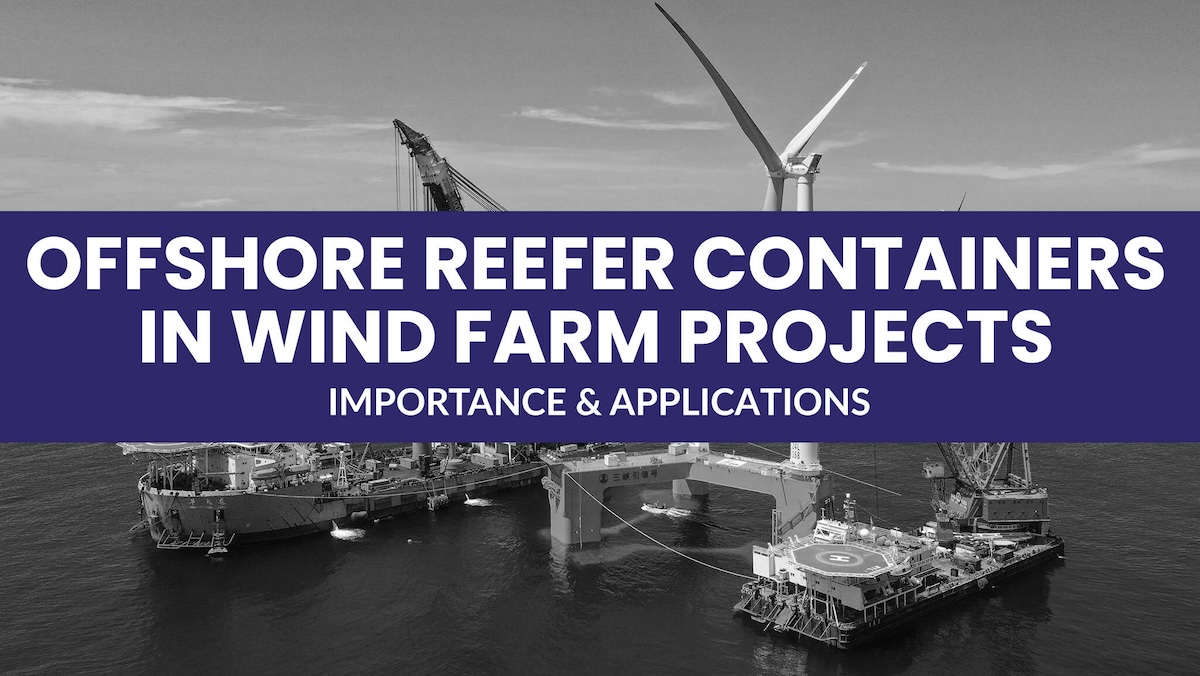Offshore reefer containers have developed into an asset that is now considered indispensable in a variety of industries as they play a critical role in ensuring the transportation of temperature-sensitive projects.
These specialised containers that preserve the integrity of goods during transit are particularly helpful in wind farm projects to ensure the safe shipment of perishable items like pharmaceuticals, food and even delicate electronics.
In this article, we will discuss what offshore reefer containers are, their important applications in wind farm projects, and the exciting future trends and technological advancements that promise to optimise their use even further. These applications include storing food and other perishable items at temperatures below 0 degrees Celsius.
What is an Offshore Reefer Container?
Before delving into their applications, it’s essential to understand what offshore reefer containers are. These containers are specially designed refrigerated units used for transporting temperature-sensitive goods, maintaining a controlled environment throughout their journey.
In practice, these controlled and regulated containers come equipped with advanced remote temperature monitoring systems, ensuring that the interior environment remains within specified temperature ranges. This level of precision is essential for various industries, but it is especially critical for wind farm projects.
Their versatility and reliability has made them a linchpin in global supply chains— facilitating efficient movement of goods globally whilst maintaining product quality and compliance with regulatory standards.
Application of offshore reefer containers in wind farm projects
Offshore reefer containers have several applications across wind farm projects that leverage their unique reliability and protection characteristics, namely:
Equipment preservation
One of the most vital applications of offshore reefer containers in wind farm projects is equipment preservation. Wind farms rely on a multitude of sensitive equipment, from gearboxes and generators to electronic components and instrumentation.
These components are exposed to harsh offshore conditions, including saltwater, humidity, and extreme temperatures.
Reefer containers provide a safe haven for these critical components. By maintaining a stable internal climate, they prevent corrosion, condensation, and temperature-related damage.
Fundamentally, this preservation significantly extends the lifespan of wind farm tools and machinery, reducing downtime and replacement costs.
Transportation of materials for living quarters on offshore wind farms
Offshore wind farm projects often involve accommodating personnel on-site for extended periods. This necessitates the transportation of various perishable materials, including pharmaceuticals, meats, vegetables, and other necessities, to the living quarters on the wind farms.
Reefer containers play a pivotal role in this process by ensuring the safe transport of temperature-sensitive goods.
The precise temperature control guarantees the freshness and safety of these provisions, contributing to the public health and productivity of the workforce on the wind farm.
On-site storage solutions
Another critical aspect of wind farm projects is on-site storage. Reefer containers offer an ideal solution for this requirement. They provide temperature-controlled storage options, allowing for the safekeeping of spare parts, tools, and supplies directly on the wind farm site.
Having these containers on-site consequently eliminates the need for time-consuming trips to shore for equipment and supplies, enhancing the efficiency of wind farm operations. Furthermore, it ensures that these items remain in optimal condition until they are needed, reducing waste and minimising project delays.
Future trends and the role of technology in optimising their use in wind farms
The future of offshore reefer containers in wind farm projects looks promising, thanks to ongoing technological advancements. Here are some key trends to watch out for:
- Energy efficiency: Manufacturers are continually working on making reefer containers more energy-efficient, reducing their carbon footprint and operating costs.
Read: Energy Efficiency in Offshore Reefer Containers
- Remote monitoring: Integration with IoT technology enables real-time GPS monitoring of container conditions. This ensures immediate response to any deviations from the desired temperature—further safeguarding the equipment and materials stored within.
- Customisation: Tailoring reefer containers to meet specific wind farm project requirements will become more prevalent. More customised containers may emerge to offer optimised storage and transport solutions.
- Sustainability: The industry is moving towards greener solutions, including sustainable refrigerants and materials, aligning with the overall environmental goals of wind farm projects.
Conclusion
Because of their uses in the preservation of equipment, the transportation of materials, and the provision of on-site storage solutions, offshore reefer containers have developed into an essential component in the accomplishment of the goals set forth for wind farm projects.
These containers are poised to play an even more significant role in the optimisation of wind farm operations and in the contribution to a more sustainable future as technology continues to advance at a rapid pace.
By understanding the versatility and importance of offshore reefer containers, wind farm project managers can easily make informed decisions, ensuring their ventures’ smooth progress and longevity. These containers will continue to be a valuable tool in the renewable energy sector’s toolkit as we look towards an innovative future.

Business Director
A graduate (Business) from KDU, Jason Tan, is the current Business Director (Sales) for MGS Icestorm and has been associated with the company for the past 10 years.
With over 13 years in the shipping industry, he has had a significant contribution to Malaysia’s oil and gas industry in the engine and boat supply sector.
His expertise includes managing offshore catering business, offshore reefer containers, AI technology, offshore gas tanks, A60 pressurized cabins, etc. His contributions have helped establish MGS, in partnership (joint venture) with Thermo King and Honeywell to produce state of art Offshore Reefer Container products.

